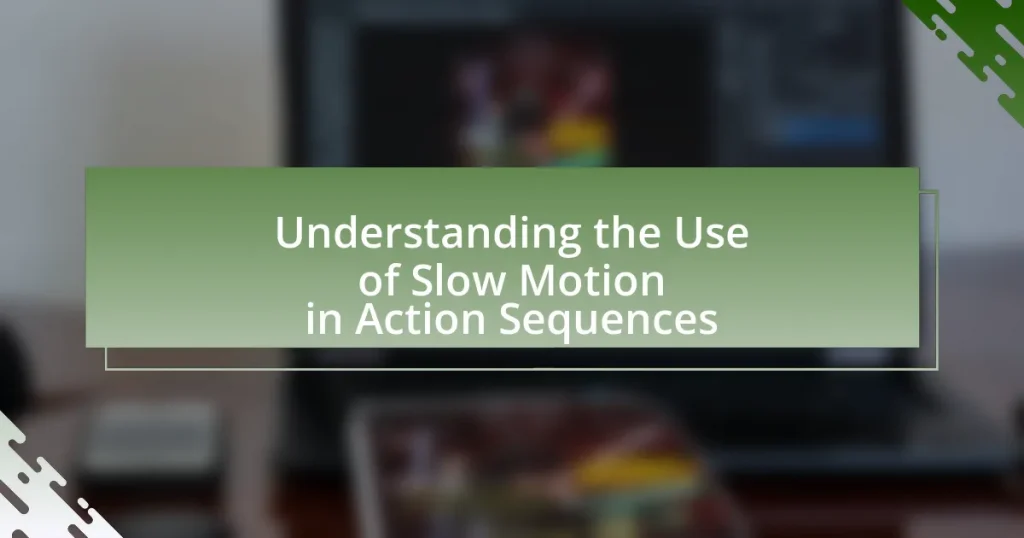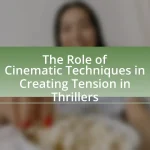Slow motion is a cinematic technique used in action sequences to reduce the speed of motion, allowing viewers to observe intricate details that would otherwise be missed. This article explores the definition, technical specifications, and emotional impact of slow motion in film and video, highlighting its role in enhancing storytelling and audience engagement. It also examines the historical development of slow motion, the influence of frame rates, and the technological advancements that have improved its application in modern cinema. Additionally, the article discusses best practices for effectively utilizing slow motion, including camera settings, sound design, and editing techniques, while addressing common challenges and pitfalls filmmakers may encounter.
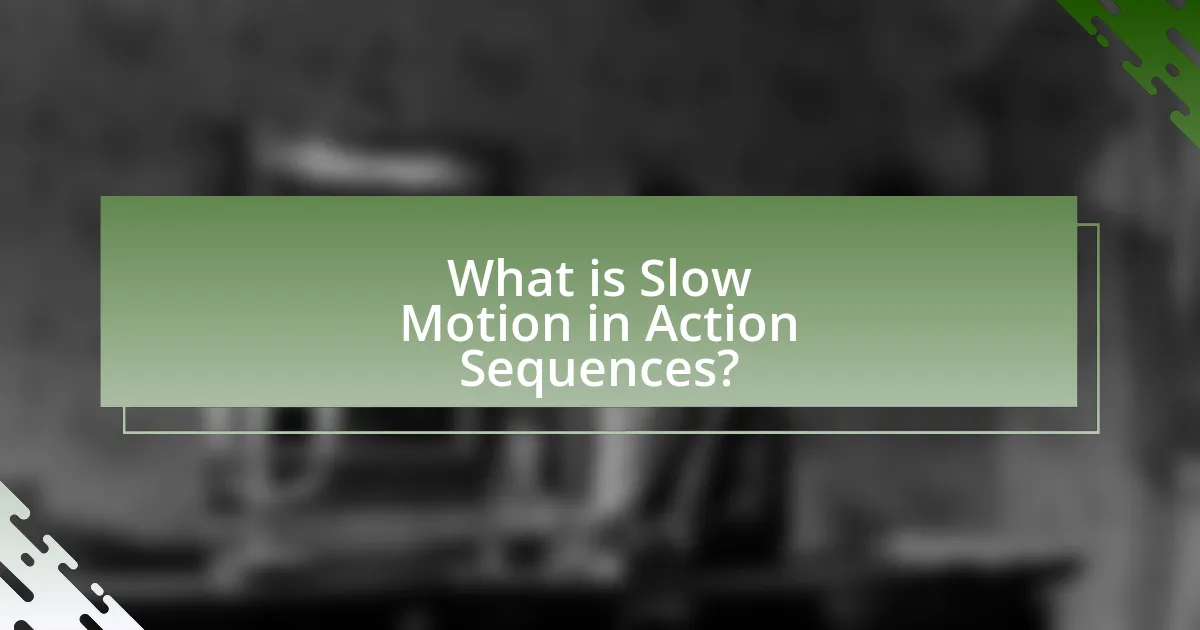
What is Slow Motion in Action Sequences?
Slow motion in action sequences is a cinematic technique that reduces the speed of motion, allowing viewers to observe details that would be missed at normal speed. This technique enhances dramatic effect, emphasizes key moments, and can create a sense of tension or beauty in the scene. For instance, films like “The Matrix” utilize slow motion during action scenes to highlight the choreography of fight sequences, making them more visually striking and impactful.
How is slow motion defined in the context of film and video?
Slow motion in the context of film and video is defined as a technique that captures footage at a higher frame rate than the standard playback speed, resulting in a playback that appears slower than real time. This technique allows filmmakers to emphasize action, create dramatic effects, and enhance visual storytelling by revealing details that are often missed at normal speed. For instance, films like “The Matrix” utilize slow motion to highlight key moments, making the action more impactful and visually striking.
What are the technical specifications of slow motion?
The technical specifications of slow motion primarily involve frame rate and playback speed. Slow motion is typically achieved by recording at a higher frame rate than the standard 24 frames per second (fps), often ranging from 60 fps to 1000 fps or more, depending on the desired effect. For instance, recording at 120 fps allows for playback at 24 fps, resulting in a 5x slow-motion effect. This technique captures more frames per second, providing smoother motion when played back at normal speed. Additionally, the resolution and sensor capabilities of the camera play a crucial role in maintaining image quality during slow motion, as higher frame rates can lead to reduced light intake, affecting exposure and clarity.
How does frame rate influence slow motion effects?
Frame rate significantly influences slow motion effects by determining how many frames are captured per second, which directly affects the smoothness and clarity of the resulting slow-motion footage. Higher frame rates, such as 120 frames per second or more, allow for more detailed motion capture, enabling smoother playback when slowed down, as each frame provides a clearer representation of the action. For instance, filming at 240 frames per second and playing it back at 24 frames per second results in a tenfold slow-motion effect, showcasing intricate details that would be lost at standard frame rates. This principle is widely utilized in filmmaking to enhance dramatic moments, as seen in action sequences where rapid movements are rendered in a visually captivating manner.
Why is slow motion used in action sequences?
Slow motion is used in action sequences to enhance dramatic effect and emphasize key moments. By slowing down the action, filmmakers allow viewers to fully appreciate the choreography, intensity, and emotional weight of critical scenes. This technique also creates a heightened sense of tension and allows for detailed visual storytelling, making the audience more engaged. For instance, in films like “The Matrix,” slow motion is employed during fight scenes to showcase the intricacies of martial arts and the characters’ agility, thereby amplifying the overall impact of the sequence.
What emotional impact does slow motion create for viewers?
Slow motion creates a heightened emotional impact for viewers by allowing them to experience moments with increased intensity and detail. This technique emphasizes critical actions, such as a character’s facial expressions or the physicality of movement, which can evoke feelings of suspense, awe, or nostalgia. Research indicates that slow motion can enhance emotional engagement by drawing attention to specific elements within a scene, making the viewer more aware of the emotional stakes involved. For example, studies have shown that scenes in slow motion can lead to stronger emotional responses, as they provide a moment for reflection and deeper connection to the narrative.
How does slow motion enhance storytelling in action scenes?
Slow motion enhances storytelling in action scenes by allowing viewers to absorb critical moments, emphasizing emotional weight and detail. This technique highlights the intensity of actions, such as a punch landing or a character’s expression, making these moments more impactful. For instance, in films like “The Matrix,” slow motion is used during fight sequences to showcase the choreography and the characters’ skills, thereby deepening audience engagement and understanding of the narrative. By slowing down time, filmmakers can create a dramatic pause that heightens tension and allows for character development, ultimately enriching the storytelling experience.
What are the historical developments of slow motion in cinema?
The historical developments of slow motion in cinema began in the late 19th century with the invention of the motion picture camera. Early pioneers like Eadweard Muybridge utilized high-speed photography to capture motion in a way that could be analyzed frame by frame. In 1912, the first use of slow motion in a narrative film occurred in “The Great Train Robbery,” where filmmakers experimented with varying frame rates to create dramatic effects.
The 1920s saw advancements in technology, with cameras capable of shooting at higher frame rates, allowing for smoother slow-motion sequences. Notably, in 1930, the film “The Big Trail” showcased slow motion to enhance the visual storytelling of action scenes.
By the 1960s and 1970s, filmmakers like Sam Peckinpah and Francis Ford Coppola popularized slow motion in action sequences, using it to heighten tension and emotional impact, as seen in “The Wild Bunch” (1969) and “Apocalypse Now” (1979).
The introduction of digital technology in the late 20th century further revolutionized slow motion, enabling filmmakers to manipulate frame rates with precision. Films like “The Matrix” (1999) utilized digital effects to create iconic slow-motion sequences, solidifying its place in modern cinema.
Overall, the evolution of slow motion in cinema reflects technological advancements and creative experimentation, enhancing the visual narrative of films throughout history.
How has technology evolved to improve slow motion techniques?
Technology has evolved significantly to improve slow motion techniques through advancements in camera frame rates, image sensors, and processing capabilities. Modern high-speed cameras can capture footage at thousands of frames per second, allowing for ultra-smooth slow motion playback that reveals details previously unseen. For instance, cameras like the Phantom Flex4K can record at up to 1,000 frames per second in 4K resolution, enhancing the clarity and quality of slow motion footage. Additionally, improvements in digital image processing algorithms enable better motion interpolation and stabilization, further refining the slow motion effect. These technological advancements have transformed the way filmmakers and content creators utilize slow motion in action sequences, making it a powerful storytelling tool.
What are some landmark films that effectively utilized slow motion?
Some landmark films that effectively utilized slow motion include “The Matrix,” “300,” and “Saving Private Ryan.” “The Matrix” is renowned for its iconic bullet-dodging scenes, which showcase slow motion to enhance the visual impact of action sequences. “300” employs slow motion to emphasize the stylized violence and dramatic moments, creating a striking visual aesthetic. “Saving Private Ryan” uses slow motion during the D-Day landing scene to heighten the emotional weight and realism of the chaos, making the viewer acutely aware of the gravity of war. Each of these films demonstrates how slow motion can be a powerful tool in storytelling and action choreography.
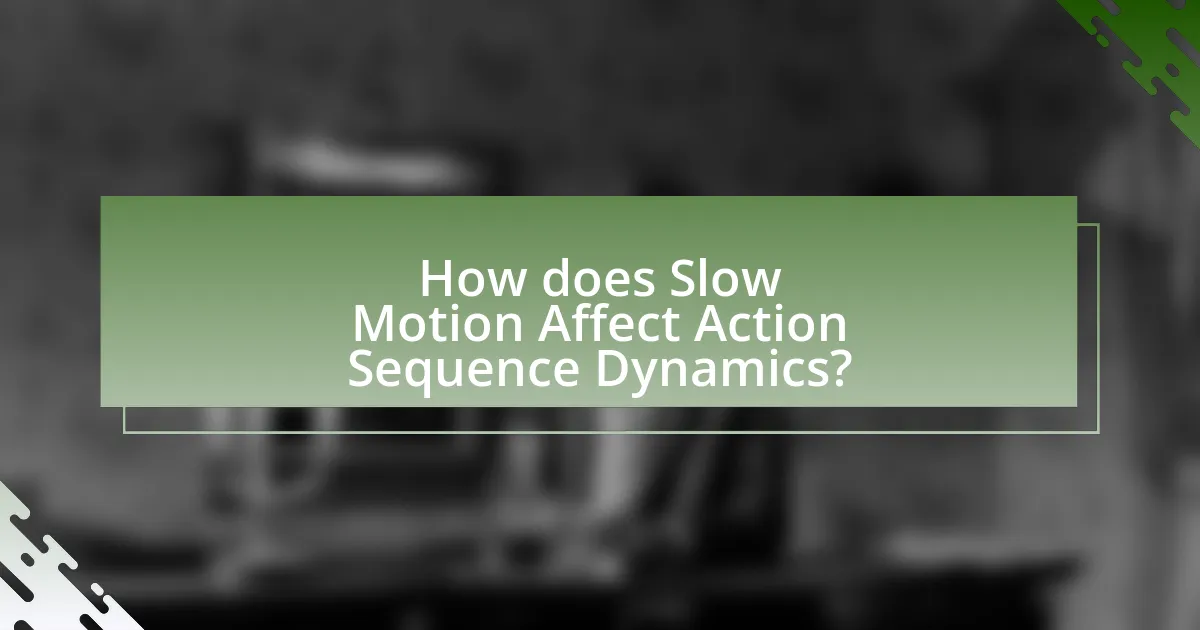
How does Slow Motion Affect Action Sequence Dynamics?
Slow motion significantly alters action sequence dynamics by extending the duration of each frame, allowing viewers to perceive details that would otherwise be missed at normal speed. This technique enhances the emotional impact and dramatic tension of scenes, as it emphasizes movements, facial expressions, and the consequences of actions. Research indicates that slow motion can increase audience engagement and heighten the sense of realism, as seen in films like “The Matrix,” where slow-motion sequences accentuate the choreography of fight scenes. By manipulating time perception, filmmakers can create a more immersive experience, making the action feel more intense and deliberate.
What are the visual effects of using slow motion in action sequences?
The visual effects of using slow motion in action sequences include heightened emotional impact, increased clarity of movement, and enhanced dramatic tension. Slow motion allows viewers to observe intricate details of fast-paced actions, such as the expressions on characters’ faces or the precise movements of objects, which would otherwise be missed at normal speed. This technique is often employed to emphasize critical moments, creating a sense of gravity and allowing audiences to fully absorb the significance of the action. For instance, in films like “The Matrix,” slow motion is used to showcase complex fight choreography, making each movement more visually striking and memorable.
How does slow motion alter the perception of speed and movement?
Slow motion significantly alters the perception of speed and movement by decelerating the visual experience, allowing viewers to observe details that are typically missed at normal speed. This technique enhances the clarity of actions, making rapid movements appear more deliberate and emphasizing the intricacies of motion, such as facial expressions or the impact of physical interactions. Research indicates that slow motion can create a heightened emotional response, as viewers are given more time to process and react to the unfolding events, thereby intensifying the overall experience of the action sequence.
What role does slow motion play in highlighting choreography and stunts?
Slow motion plays a crucial role in highlighting choreography and stunts by allowing viewers to appreciate the intricacies and details of movement. This technique enhances the visual impact of action sequences, making complex maneuvers more discernible. For instance, in films like “The Matrix,” slow motion emphasizes the fluidity and precision of martial arts choreography, allowing audiences to fully grasp the skill involved. Additionally, studies in film analysis indicate that slow motion can evoke heightened emotional responses, as it draws attention to pivotal moments, thereby enriching the overall viewing experience.
How does slow motion influence audience engagement?
Slow motion significantly enhances audience engagement by allowing viewers to process and appreciate intricate details of action sequences. This technique captures moments that would otherwise be too quick to fully comprehend, thereby increasing emotional impact and tension. Research indicates that slow motion can evoke stronger emotional responses; for instance, a study published in the journal “Cognitive Science” found that viewers rated scenes in slow motion as more intense and engaging compared to standard speed. By emphasizing critical moments, slow motion not only heightens drama but also fosters a deeper connection between the audience and the narrative.
What psychological effects does slow motion have on viewers?
Slow motion has significant psychological effects on viewers, primarily enhancing emotional engagement and perception of detail. Research indicates that slow motion can amplify feelings of awe and tension, as it allows viewers to process visual information more thoroughly, leading to a heightened emotional response. For instance, a study published in the journal “Cognitive Science” by authors such as K. M. H. van der Lubbe and J. C. C. van der Molen found that slow motion increases the viewer’s ability to recall specific details of an action scene, thereby intensifying the overall experience. This effect is particularly evident in action sequences, where the dramatic emphasis on movement can evoke stronger emotional reactions, making the experience more immersive.
How can slow motion create tension or suspense in action sequences?
Slow motion creates tension or suspense in action sequences by allowing viewers to absorb critical moments in detail, heightening emotional engagement. This technique emphasizes the stakes involved, as viewers can see the expressions of characters, the impact of actions, and the consequences of decisions unfold gradually. For instance, in films like “The Matrix,” slow motion is used during pivotal fight scenes to accentuate the danger and intensity, making each movement feel more significant. This deliberate pacing contrasts with the rapid pace of typical action, creating a sense of anticipation and dread as viewers await the outcome of the unfolding events.
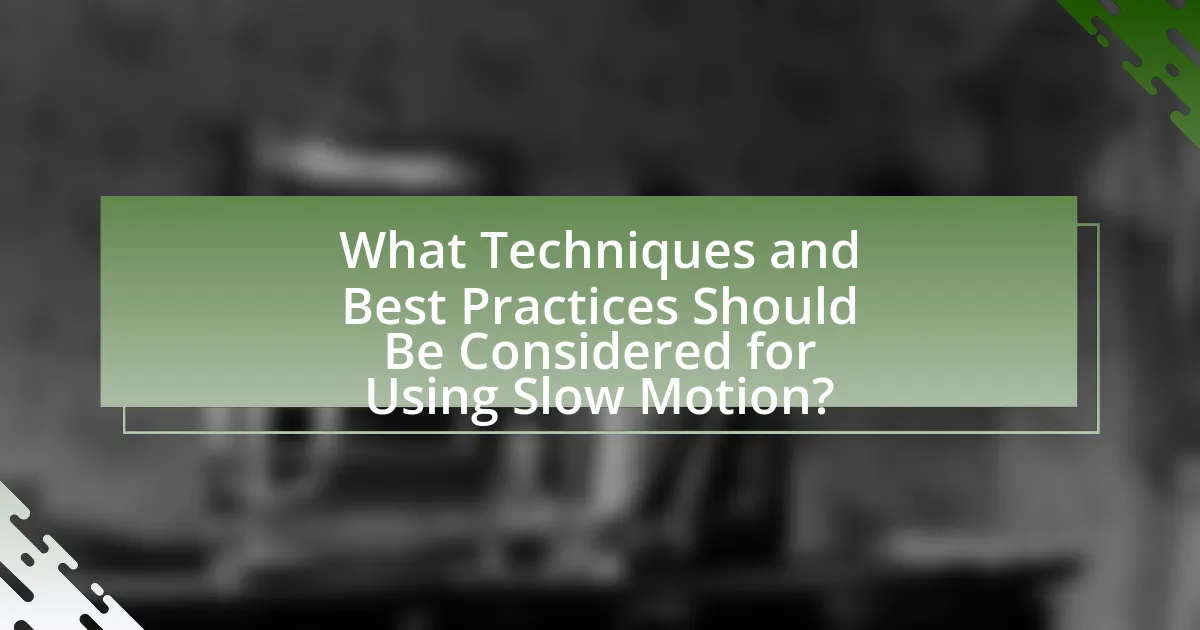
What Techniques and Best Practices Should Be Considered for Using Slow Motion?
To effectively use slow motion in action sequences, filmmakers should consider techniques such as shooting at a high frame rate, selecting appropriate moments for emphasis, and ensuring proper lighting. Shooting at a high frame rate, typically 120 frames per second or higher, allows for smoother slow-motion playback, enhancing the visual impact. Selecting moments that benefit from slow motion, such as key actions or emotional beats, helps to draw the audience’s attention and create dramatic tension. Proper lighting is crucial, as slow motion can amplify motion blur; thus, adequate illumination ensures clarity and detail in the footage. These practices are supported by industry standards, where high frame rates are commonly used in professional cinematography to achieve desired slow-motion effects.
What are the common techniques for shooting slow motion effectively?
Common techniques for shooting slow motion effectively include using high frame rates, proper lighting, and stabilization methods. High frame rates, typically 120 frames per second or higher, capture more detail in motion, allowing for smoother slow-motion playback. Adequate lighting is crucial because higher frame rates require more light to maintain image quality; insufficient lighting can lead to grainy footage. Stabilization methods, such as using gimbals or tripods, help reduce camera shake, ensuring that the slow-motion effect appears fluid and professional. These techniques are widely recognized in the film industry, as evidenced by their frequent use in action sequences to enhance visual storytelling.
How do camera settings impact the quality of slow motion footage?
Camera settings significantly impact the quality of slow motion footage by determining frame rate, shutter speed, and resolution. A higher frame rate, such as 120 frames per second or more, captures more detail during motion, resulting in smoother slow motion playback. For instance, shooting at 240 fps allows for a more fluid representation of fast actions compared to standard 24 fps. Additionally, the shutter speed must be adjusted to match the frame rate; a general rule is to set the shutter speed to double the frame rate to avoid motion blur, which can degrade the clarity of the footage. For example, if filming at 120 fps, a shutter speed of 1/240 seconds is ideal. Lastly, higher resolution settings ensure that the details remain sharp when slowed down, as lower resolutions can lead to pixelation and loss of quality. Thus, optimal camera settings are crucial for achieving high-quality slow motion footage.
What types of cameras are best suited for capturing slow motion?
High-speed cameras are best suited for capturing slow motion. These cameras can record at frame rates of 240 frames per second (fps) or higher, allowing for smooth playback at reduced speeds. For example, professional models like the Phantom Flex4K can achieve frame rates exceeding 1,000 fps, providing exceptional detail in slow-motion footage. Additionally, DSLRs and mirrorless cameras with high frame rate capabilities, such as the Sony A7S series, also perform well for slow-motion capture, typically offering 120 fps at 1080p resolution.
What are the challenges of using slow motion in action sequences?
The challenges of using slow motion in action sequences include the potential for loss of clarity and the need for precise timing. Slow motion can obscure fast-paced movements, making it difficult for viewers to follow the action, especially if the choreography is complex. Additionally, achieving the desired effect requires careful planning and execution, as filming at high frame rates can lead to increased production costs and technical difficulties. For instance, shooting at 120 frames per second or higher necessitates specialized equipment and can complicate lighting conditions, which may affect the overall visual quality of the sequence.
How can motion blur affect the clarity of slow motion shots?
Motion blur can significantly reduce the clarity of slow motion shots by obscuring fine details and making the image appear less sharp. In slow motion, the frame rate is increased, which can accentuate motion blur if the shutter speed is not appropriately adjusted. For instance, a slower shutter speed captures more motion blur, leading to a loss of detail in fast-moving subjects. Research indicates that optimal shutter speeds for slow motion should be at least double the frame rate to minimize motion blur and maintain clarity, as demonstrated in cinematography guidelines.
What are the common pitfalls to avoid when using slow motion?
Common pitfalls to avoid when using slow motion include overusing the effect, which can lead to a loss of impact and viewer engagement. Additionally, failing to match the frame rate to the action can result in choppy footage, detracting from the intended smoothness of the slow motion. Poor audio synchronization is another issue, as slow motion can distort sound, making it crucial to adjust audio tracks accordingly. Lastly, neglecting to consider the narrative context can make slow motion feel out of place, undermining the story’s emotional weight.
What tips can filmmakers follow to maximize the impact of slow motion?
Filmmakers can maximize the impact of slow motion by carefully selecting moments that enhance emotional resonance and visual storytelling. Utilizing slow motion during pivotal action sequences, such as a character’s moment of triumph or a dramatic confrontation, allows audiences to absorb the intensity and significance of the scene. Additionally, pairing slow motion with a well-chosen soundtrack can amplify the emotional weight, as seen in films like “300,” where slow motion emphasizes the gravity of battle scenes. Furthermore, maintaining a consistent frame rate, typically shooting at 120 frames per second or higher, ensures smooth playback and enhances the visual quality of the slow-motion effect. This technique has been effectively employed in various action films to create a more immersive experience for viewers.
How can sound design complement slow motion in action sequences?
Sound design can enhance slow motion in action sequences by creating a heightened sense of drama and emotional impact. When action is slowed down, the auditory elements, such as sound effects and music, can be manipulated to match the visual pacing, allowing viewers to absorb the intensity of the moment. For instance, the use of low-frequency rumbles or echoes can amplify the weight of a punch or the rush of wind, making the scene feel more immersive. Research indicates that synchronized sound and visuals can significantly affect audience perception, as demonstrated in studies showing that well-timed sound effects can increase the perceived realism and emotional engagement in cinematic experiences.
What editing techniques enhance the effectiveness of slow motion footage?
Editing techniques that enhance the effectiveness of slow motion footage include careful timing adjustments, the use of sound design, and color grading. Timing adjustments allow editors to select the most impactful moments to slow down, emphasizing critical actions or emotions. Sound design plays a crucial role by either enhancing the audio to match the slow motion or incorporating dramatic sound effects that complement the visuals. Color grading can also enhance the mood and tone of the footage, making the slow motion more visually striking. These techniques collectively contribute to a more immersive and engaging viewer experience, as evidenced by their frequent use in high-impact films and action sequences.
